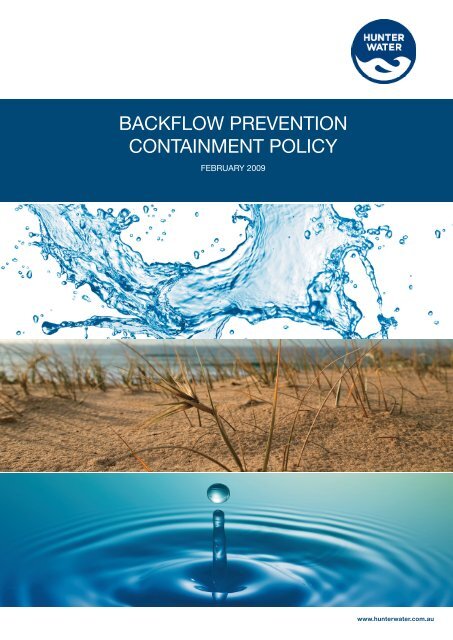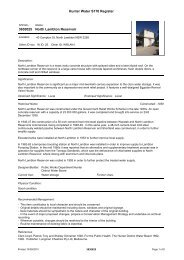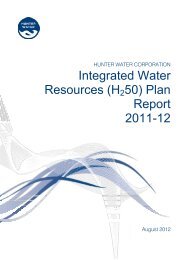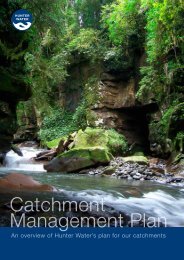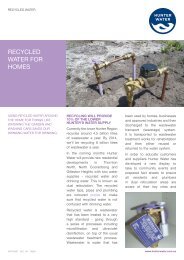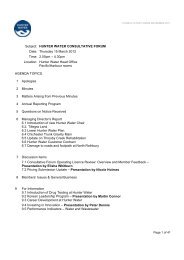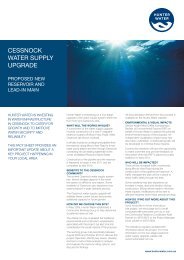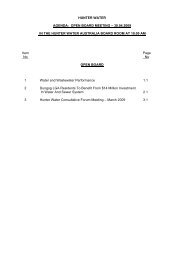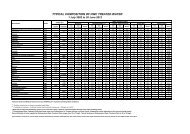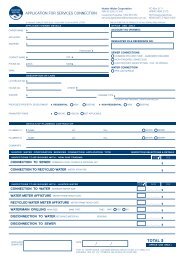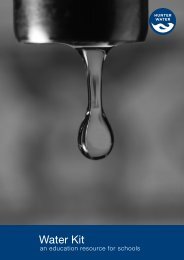BACKFLOW PREVENTION CONTAINMENT POLICY - Hunter Water
BACKFLOW PREVENTION CONTAINMENT POLICY - Hunter Water
BACKFLOW PREVENTION CONTAINMENT POLICY - Hunter Water
Create successful ePaper yourself
Turn your PDF publications into a flip-book with our unique Google optimized e-Paper software.
<strong>BACKFLOW</strong> <strong>PREVENTION</strong><br />
<strong>CONTAINMENT</strong> <strong>POLICY</strong><br />
February 2009<br />
www.hunterwater.com.au
QA SUMMARY – Changes to Policy<br />
Version Number<br />
Reference<br />
Change<br />
Details<br />
and Date<br />
or<br />
Site Item<br />
<strong>Hunter</strong> <strong>Water</strong> Corporation<br />
2<br />
February 2009<br />
Backflow prevention policy
TABLE OF CONTENTS<br />
1 INTRODUCTION: 4<br />
1.1 Referenced Documents: 4<br />
1.2 Causes Of Backflow: 5<br />
2 <strong>BACKFLOW</strong> <strong>PREVENTION</strong> <strong>POLICY</strong> 5<br />
2.1 Backflow Prevention Device Installations. 5<br />
2.2 Conditions of Installation 6<br />
2.3 Operational Principles 8<br />
3 DISPUTE RESOLUTION 10<br />
5 DEFINITIONS: 11<br />
<strong>Hunter</strong> <strong>Water</strong> Corporation<br />
3<br />
February 2009<br />
Backflow prevention policy
1 INTRODUCTION:<br />
This Backflow Prevention Policy applies to all customers connected to <strong>Hunter</strong> <strong>Water</strong>’s water<br />
supply.<br />
Backflow prevention refers to the control of potentially harmful contaminants entering the<br />
Corporation’s potable drinking water supply from cross connections in a customer’s premises<br />
or backflow of contaminants into the water supply system.<br />
The purpose of this policy is to ensure that the <strong>Hunter</strong> <strong>Water</strong> Corporation exercises the<br />
required duty of care in the protection of the potable water supply and to safeguard public<br />
health within its area of operation as set out in the <strong>Hunter</strong> <strong>Water</strong> Corporation Act, Operating<br />
Licence and Customer Contract. The owners of premises also have a duty of care to prevent<br />
such an occurrence, as well as maintaining responsibility for safe water supply within their<br />
own boundaries.<br />
The objectives of the policy are to:<br />
1. protect the integrity of the water supply; and<br />
2. protect the health and safety of consumers.<br />
The policy details the types of backflow prevention device required for customers’ properties<br />
with low, medium or high hazards as defined in Australian/ New Zealand Standard AS/NZS<br />
3500, Part 1 <strong>Water</strong> Services (AS/NZS 3500) and the obligations property owners.<br />
The policy details the requirements for containment protection (site protection) at the<br />
property boundary. Protection within individual premises (zone protection) is entirely the<br />
responsibility of property owners and, as such, is not covered in this policy. Customers<br />
should refer to the NSW Code of Practice Plumbing and Drainage and AS/NZS 3500 for<br />
requirements<br />
1.1 Referenced Documents:<br />
The policy is consistent with the aims of The National Plumbing & Drainage reform agenda,<br />
Plumbing Code of Australia, NSW Code of Practice Plumbing & Drainage, National Plumbing<br />
<strong>Hunter</strong> <strong>Water</strong> Corporation<br />
4<br />
February 2009<br />
Backflow prevention policy
& Drainage Code Australian/New Zealand Standard 3500 (AS/NZS 3500.1), <strong>Hunter</strong> <strong>Water</strong>’s<br />
Operating Licence, Act, regulations and the Customer Contract.<br />
1.2 Causes Of Backflow:<br />
Backflow in this context can be defined as the unintended flow of water from a potentially<br />
polluted source into the potable water supply. Backflow can be caused by either back<br />
pressure from pressurisation equipment on the customer’s premises or siphonage caused<br />
when the pressure in the water supply system falls below atmospheric pressure.<br />
The pressure differential can be affected by a number of circumstances including;<br />
• A break in the water main<br />
• During a fire when water is being pumped from the mains<br />
• A customer using water on site at a higher pressure than the supply pressure (eg<br />
operating a pump)<br />
• Heavy usage from a customer downstream, reducing water pressure upstream.<br />
The problem arises if there is an interconnection between the customer’s water service and a<br />
contaminated source thus providing the possibility of drawing back into the mains system,<br />
pollutants, or contaminants that may provide a risk to public health.<br />
2 <strong>BACKFLOW</strong> <strong>PREVENTION</strong> <strong>POLICY</strong><br />
All properties with <strong>Hunter</strong> <strong>Water</strong>’s area of operation must comply with the requirements of the<br />
NSW Code of Practice Plumbing and Drainage and AS/NZS 3500. All properties with a water<br />
connection that present a high, medium or low hazard rating shall install appropriate<br />
backflow prevention at the boundary for containment protection purposes. Backflow<br />
prevention is necessary to ensure the water supply system is protected from the backflow of<br />
contaminants into the public water supply.<br />
2.1 Backflow Prevention Device Installations.<br />
The type of backflow prevention device is dictated by the potential hazard that may exist in<br />
particular types of businesses or use. The types of devices and the hazard ratings for<br />
<strong>Hunter</strong> <strong>Water</strong> Corporation<br />
5<br />
February 2009<br />
Backflow prevention policy
particular uses are set out in AS/NZS 3500. All devices must be installed in accordance with<br />
the NSW Code of Practice Plumbing and Drainage and AS/NZS 3500.<br />
2.1.1 New Developments and Re-developments<br />
All new customers with high or medium hazard installations or processes on their properties<br />
will be identified via an application for hydraulic services approval as detailed in NSW Code<br />
of Practice and an application for a Section 50 certificate. Customers via this application will<br />
be notified with the requirement to comply with the Backflow Prevention Policy before<br />
connection to the water supply being granted. Customers will also be informed by a HWC<br />
representative of the need to comply with the Backflow Prevention Policy upon a plumbing<br />
and drainage inspection identifying a high or medium hazard process being found.<br />
2.1.2 Existing Residential and Non Residential Customers<br />
All existing customers whose properties have high or medium hazards are required to<br />
comply with the Backflow Prevention Policy, as stated in The NSW Code of Practice<br />
Plumbing and Drainage Part B 2.2.9. AS 3500 identifies the industry types and processes<br />
which require testable backflow prevention containment devices. Customers that are<br />
identified by HWC will be issued a Notice of Repair and given a specific period in which<br />
to comply.<br />
2.1.3 Recycled <strong>Water</strong> Schemes<br />
Where <strong>Hunter</strong> <strong>Water</strong> supplies a customer with recycled water, the customer must install<br />
backflow prevention on the recycled water system or standpipe equivalent to the backflow<br />
prevention required for the drinking water supply.<br />
The drinking water supply to this property shall also be compliant with the backflow<br />
prevention requirements for site and zone containment.<br />
2.2 Conditions of Installation<br />
1. Where the hazards are unknown for a commercial, industrial or mixed development, the<br />
hazard rating will default to high, requiring the installation of a device appropriate for that<br />
hazard rating. If the hazard rating varies due to multiple processes or multiple tenants,<br />
the highest hazard rating shall be applied.<br />
<strong>Hunter</strong> <strong>Water</strong> Corporation<br />
6<br />
February 2009<br />
Backflow prevention policy
2. All backflow prevention devices must be installed, commissioned and tested by a<br />
licensed plumber with backflow prevention accreditation<br />
3. Only backflow prevention devices manufactured and quality assured to AS/NZS 2845<br />
are to be installed on metered standpipes and properties within <strong>Hunter</strong> <strong>Water</strong>’s area of<br />
responsibility.<br />
4. The type of device installed shall be in accordance with the hazard rating of the<br />
processes conducted.<br />
5. All High Hazard installations shall be fitted with either a Reduced Pressure Zone Device<br />
(RPZD) or Registered Break Tank (RBT) or Registered Air Gap.<br />
6. Medium hazards require the installation of a Testable Double Check Valve as a<br />
minimum.<br />
7. Metered standpipes require a Non Testable Double Check Valve. The device shall be<br />
integrated into the design of the standpipe. All water carts and fill stations shall have a<br />
registered air gap or reduced pressure zone device at the fill point<br />
8. Separate hydrant and sprinkler fire services require the installation of a Testable Double<br />
Check Detector Check assembly. The device shall be installed close to where the water<br />
service crosses the property boundary, prior to any suction on booster assembly.<br />
9. On a drinking water service, the device shall be installed on the customer’s side of the<br />
water meter with no connections between the water meter and the device.<br />
10. All property services shall have a water meter affixed including a detector check bypass<br />
for fire services.<br />
11. Where a 20mm or 25mm meter is used for the connection of a property, considered to<br />
be a Low Hazard risk, the property shall be fitted with an approved meter, supplied by<br />
<strong>Hunter</strong> <strong>Water</strong> at the time of connection, which incorporates an integral Dual Check<br />
valve. The property owner is responsible for applying to <strong>Hunter</strong> <strong>Water</strong> for an Integral<br />
Dual Check Valve water meter. The owner shall provide access to the water meter at all<br />
times.<br />
<strong>Hunter</strong> <strong>Water</strong> Corporation<br />
7<br />
February 2009<br />
Backflow prevention policy
12. Owners of new residential premises connected using a meter larger than 25mm shall fit<br />
an appropriate BPD as required in the NSW Code of Practice Plumbing & Drainage and<br />
as specified in AS/NZS 3500.<br />
13. If the usage, and hence the hazard rating, of a premises changes, the owner shall be<br />
required to install the appropriate Backflow Prevention Device.<br />
14. Conditions apply for other uses of <strong>Hunter</strong> <strong>Water</strong>’s drinking water supply i.e. water<br />
tankers and standpipes. These shall be registered, be inspected annually and must have<br />
an air gap or approved backflow protection device.<br />
15. The water meter set shall not be altered (eg; removal of the meter spacer and dirt box<br />
are not permitted).<br />
2.3 Operational Principles<br />
1. Backflow Prevention Devices are required to be installed, inspected and maintained in<br />
accordance with the NSW Code of Practice Plumbing & Drainage and AS/NZS 3500.<br />
Customers are required to register the device with <strong>Hunter</strong> <strong>Water</strong> upon commissioning.<br />
2. The cost of the backflow prevention device, installation, testing, inspection and ongoing<br />
maintenance will be the responsibility of the owner of the property for all devices other<br />
than Low Hazard 20mm and 25mm meter installations.<br />
3. The property owner is responsible for ensuring that an annual test of any Testable<br />
backflow prevention device is carried out in accordance with the NSW Code of Practice<br />
and AS/NZS 3500.<br />
4. The registration of tests and inspection shall be carried out by <strong>Hunter</strong> <strong>Water</strong> upon<br />
payment of the prescribed fee. <strong>Hunter</strong> <strong>Water</strong> may choose to audit the test report and<br />
inspection. Backflow Prevention Device Inspection and Maintenance Report forms are<br />
available for purchase from <strong>Hunter</strong> <strong>Water</strong> Corporation Offices.<br />
5. If <strong>Hunter</strong> <strong>Water</strong> determines that the backflow prevention device is unsatisfactory and<br />
issues a notice requiring the customer to repair, maintain, test, replace or install a<br />
<strong>Hunter</strong> <strong>Water</strong> Corporation<br />
8<br />
February 2009<br />
Backflow prevention policy
ackflow prevention device, the customer shall, at the customer’s expense, comply<br />
with the notice within the time specified in the notice.<br />
6. If the customer fails to install, repair, maintain, replace or test a backflow prevention<br />
device as required by a notice issued by <strong>Hunter</strong> <strong>Water</strong>, <strong>Hunter</strong> <strong>Water</strong> may disconnect<br />
in the case of a non-residential property or restrict in the case of a residential property<br />
or mixed development the water supply system until such time as the customer has<br />
complied with the notice to carry out works, as may be necessary to prevent<br />
contamination of the water supply.<br />
7. If the customer does not comply with the notice, <strong>Hunter</strong> <strong>Water</strong> may undertake to<br />
remedy the defective work. The customer may be charged the cost incurred in<br />
undertaking this work.<br />
8. Existing customers connected to the water supply must install a backflow prevention<br />
device within the timeframe specified on a notice issued by <strong>Hunter</strong> <strong>Water</strong>.<br />
9. Where a Testable BPD is installed, it shall be installed by a licensed plumber but must<br />
be commissioned and tested by a plumber with the appropriate backflow prevention<br />
training and accreditation.<br />
10. Installation and test certificates must be received by <strong>Hunter</strong> <strong>Water</strong> within five working<br />
days of the completion of the property service.<br />
11. A person must be authorised to draw water or connect to the <strong>Hunter</strong> <strong>Water</strong>’s water<br />
supply system and must not introduce a contaminant to the system. The connection<br />
point shall be a suitable backflow prevention device installed inline and immediately at<br />
the utilities connection point.<br />
<strong>Hunter</strong> <strong>Water</strong> Corporation<br />
9<br />
February 2009<br />
Backflow prevention policy
3 Penalties for Non-compliance<br />
If the customer fails to install, repair, maintain, replace or test a backflow prevention device<br />
(as per AS3500 and NSW Code of Practice) as required by a notice issued by <strong>Hunter</strong> <strong>Water</strong>,<br />
<strong>Hunter</strong> <strong>Water</strong> may utilise the provisions of the Customer Contract, Clause 6.3 (Disconnection<br />
or restriction) and Clause 8.5 (Defective work) until such time as the customer has complied<br />
with the notice.<br />
4 Dispute Resolution<br />
Any disputes which arise from the operation of this policy will be dealt with using <strong>Hunter</strong><br />
<strong>Water</strong>’s customer dispute resolution procedures.<br />
<strong>Hunter</strong> <strong>Water</strong> Corporation<br />
10<br />
February 2009<br />
Backflow prevention policy
5 DEFINITIONS:<br />
Backflow Prevention device (BPD) is defined in AS/NZS 3500- as a device which will<br />
prevent reverse flow of water from a potentially polluted source into the water supply system.<br />
Containment Protection (Site protection) is the installation of a backflow prevention device<br />
on the water service at the property boundary between the distribution system and the<br />
owner’s property.<br />
Zone Protection is the installation of backflow prevention devices within sections of the<br />
owner’s property.<br />
Individual Protection is the installation of a backflow prevention device at the water<br />
connection to an individual apparatus.<br />
Cross Connection is any connection or arrangements between the drinking water supply<br />
system connected to the water main or any fixture, which may under certain conditions<br />
enable non-drinking water or other substances to enter the drinking water supply system.<br />
High Hazard Rating (AS/NZS 3500) - any condition, device or practice which in connection<br />
with the potable water supply system has the potential to cause death.<br />
Medium Hazard Rating (AS/NZS 3500) - any condition, device or practice which in<br />
connection with the potable water supply system has the potential to endanger health.<br />
Low Hazard Rating (AS/NZS 3500) - any condition, device or practice which in connection<br />
with the potable water supply system would constitute a nuisance but not endanger health or<br />
cause injury.<br />
<strong>Hunter</strong> <strong>Water</strong> Corporation<br />
11<br />
February 2009<br />
Backflow prevention policy


